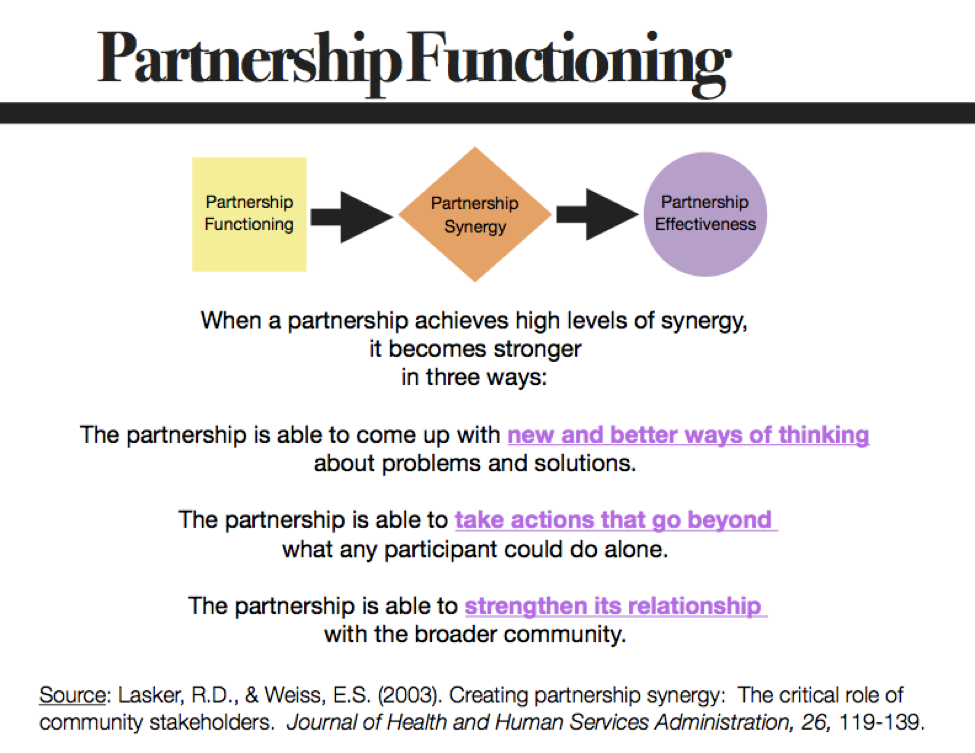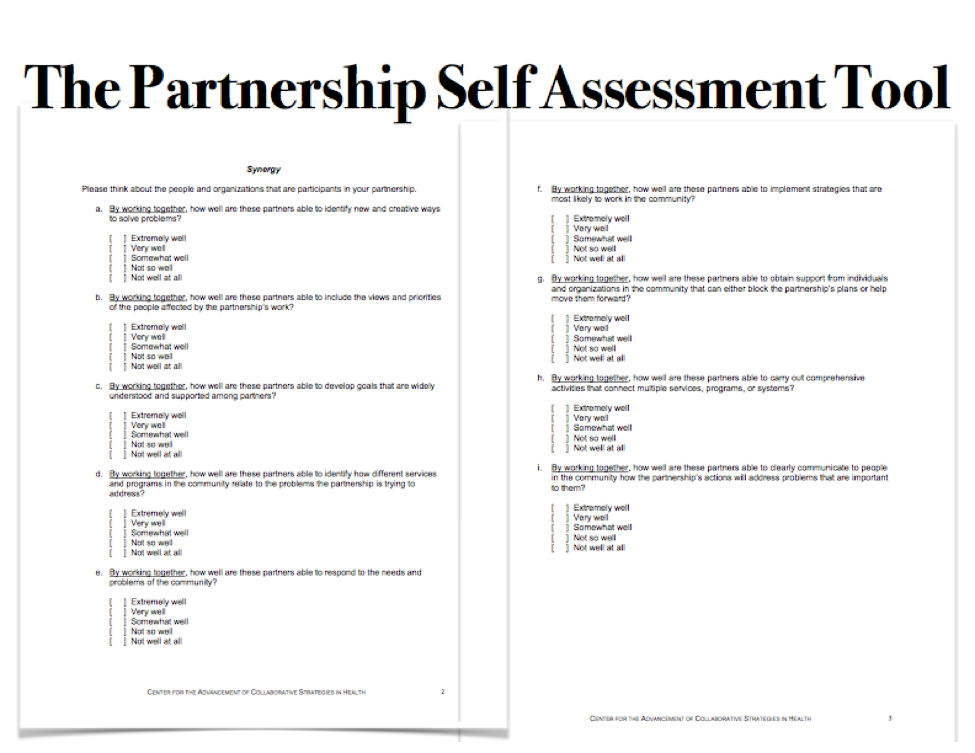My name is Sharon M. Wasco and, as a community psychologist, I frequently adopt participatory approaches to evaluation. I often say, “Commitment to collaboration guides my work,” and this post is organized to answer three questions about collaboration.
Hot Tip: What does collaboration mean? To me, collaboration means two or more partners working together in ways that increase capacity to achieve a stated goal.
Below is my visualization of Chris Huxham’s (1996) typology of ways that organizations (and/or individuals) can work together. Collaboration is the highest level of functioning, with capacity building as the collaborative advantage.

Cool Trick: How can we observe — or recognize — collaboration in our work? Synergy can be used as an indicator of collaboration.
The Center for the Advancement of Collaborative Strategies in Health developed a theoretical framework that specified SYNERGY as a measurable output of a collaborative relationship, and as a precondition of partnership effectiveness.

Rad Resource: Can collaboration be measured? The Partnership Self Assessment Tool is a survey and a process to measure collaboration in the field. There are nine items that make up the measure of synergy, as shown below.

Along with partners at the Florida Coalition Against Domestic Violence and Strategic Prevention Solutions, I’ve used this tool in the evaluation of a five-year primary prevention initiative focused on strategies at the “outer layers” of the SEM.
FCADV’s community and social change efforts included Coalition Building, which has been defined as “a strategy designed to increase two or more organizations’ abilities to work collaboratively on statewide or community prevention programs, policies, or resources” (read more about IPV prevention strategies here).
FCADV-Certified DV Centers convened Community Action Teams (CATs) to plan and implement prevention activities in over 40 diverse communities across Florida. The PSAT allowed us to measure increased collaboration and to document success of the CATs!

Hot Tips: Not every working group is meant to collaborate. A partnership has been defined as a group of people and organizations 1) that continually work together to develop and modify strategies to achieve their goals 2) has begun to take action to implement its plans 3) has at least five active members 4) exists for at least six months.
To qualify as a group-level indicator, PSAT methodology requires at least 65% of the group to complete the survey within thirty days.
Rad Resources: Read more about different working relationships in the Community Toolbox.
Read more about the Centers for Disease Control and Prevention’s (CDC’s) Domestic Violence Prevention Enhancements and Leadership Through Alliances, Focusing on Outcomes for Communities United with States‘s (DELTA FOCUS) initiative to prevent intimate partner violence.
Find the Partnership Self-Assessment Tool on the registry of the National Collaborating Centre for Methods and Tools.
The American Evaluation Association is celebrating CP TIG Week with our colleagues in the Community Psychology Topical Interest Group. The contributions all week come from CP TIG members. Do you have questions, concerns, kudos, or content to extend this aea365 contribution? Please add them in the comments section for this post on the aea365 webpage so that we may enrich our community of practice. Would you like to submit an aea365 Tip? Please send a note of interest to aea365@eval.org.

Hi Lola,
Thank you for reading this post, and for your comments. I completely agree with your point that groups or partnerships need a process, time, resources, and tools to learn how to collaborate.
I have found the full PSAT very helpful as a start to this because the indicators (especially for leadership and administrative/management scales) define critical pieces of the collaborative process. As an example, even just recognizing that something like “establishing common language” within a multidisciplinary group is a form of leadership in partnerships helps get closer to that synergy that leads to measurable change.
Let’s stay in touch, and please do share if you come across any additional tips for facilitating collaboration.
Thanks!
Dear Sharon,
Thank you for your article, I like how the visualizations you included makes it very clear what the differences between the four terms networking, coordination, cooperation, and collaboration means. I am currently a student in a program evaluation course, and I found your article interesting because collaboration and working relationships are so important in so many aspects, not only professionally but personally as well. It’s amazing that you were able to measure increased collaboration in over 40 diverse communities! I find the partnership self assessment tool very thorough as it touches on so many aspects that affect collaborative work. I hope to refer to the partnership self assessment tool more often when I am working with a partner or in a group to remember what positive collaboration may be able to yield.
You mentioned that not every group is meant to collaborate and from past personal experience, I agree with that statement. However, I think that a lot of times people need to be taught how to collaborate. That is an area I personally think we need more resources in, especially since in today’s generation so many occupations, school assignments, and learning tasks are done collaboratively. Perhaps in the future we can see not only tools that measure collaboration but also tools that can enhance collaboration skills.
Lola